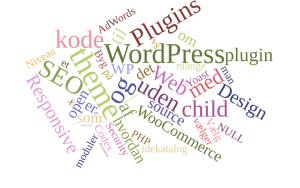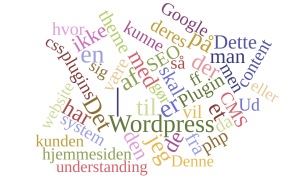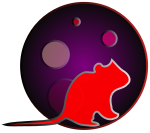Wordcloud 1: Destillation of Ideas

The word-clouds are alchemic destillations of my literature review so far. I saved 500+ quotes from student reports and academic papers about WordPress in a MySQL database. I printed out all the quotes in one long string from the database.
The actual word-clouds are made by a Chrome plugin. The clouds are a data visualizations. They will show the frequency of the words that WordPress professionals or scholars use. Size matters here. Big words are words that occur often in my notes.
The first cloud is made by my sum up of the notes from the reports. After reading the text I summed up the basic ideas. The first cloud is a visualization of my interpretation of the research texts.
At this point of the literature review the works of students dominate. The words come from my hermeneutic coding or sum up of internship reports, final reports, BA thesises and around 10 scientific articles on WordPress.
A cloud like this is an answer to my research question:
What should you know about WordPress?
Here the answer is:
- Plugins
- SEO
- Theme
- Child theme
- Code (= da. kode)
- WooCommerce
- Responsive Web Design
Wordcloud 2: Quotations and notes
The next word-cloud is the result of all the notes and quotations from these texts.

Since most of the reports are in danish the clouds will have many danish words. However most words about the WordPress craft are in english.
The second wordcloud is very similar to the first one. However we get options like:
- CMS
- PHP
- Customer
- Content
- Google SEO, AdWords etc.
- CSS
So these clouds are visual answers to my research question.
If I remove the academic papers, the word-cloud looks like the one below. I have removed a long string of common words in order to get a WordPress-specific cloud. Else I’d get a cloud with tons on and, or, when and what not. Below is the cloud.

The cloud does not add much new stuff. However there is more emphasis on the customers (da. “kunden”). The prominent words are:
- Customer (da. = kunden)
- Plugin(s)
- CMS
- SEO
- Content
- theme
- code (da. = kode)
It’s strange to see that PHP, CSS and Jquery does not play a prominent role here. Here I think that the data visualization gives a wrong impression.
Strange findings
During the initial phases of my research project I asumed that a WordPress professional would be nerdy. Stuff like advanced CSS, Jquery, MySQL, SQL, ER-diagrams, preprocessors, Gulp, Nodejs and so on should dominate the picture.
These word clouds demonstrate, that my initial hypothesis was not precise.
In fact many WordPress professionals build custom made solutions without much code at all. Some professionals use one theme for all. What you can achieve with WordPress without code is important.
On the other hand there is a huge difference between haute couture and pret a porter.
Perhaps the real secret behind the success of WordPress is the ease of use. Using WordPress is not that different from the feeling of using a word processor such as Libre Office or MS Word.
Literature Review
The word-clouds are a kind of sum up of my literature review so far. During the next phase I will focus on interviews with WordPress practitioners and professionals. Can they recognize the vision in the clouds?
That’s what I’ll investigate during the next spin of the hermeneutic circle.
The word-clouds visualize the hermeneutic codes as stored in my database with notes and quotes. What they say is interesting – but we should not forget, that the clouds only gives a fragment of the picture.
Perhaps important methods are only mentioned once. Or even not at all. In that case such topics will not be visible in the word-clouds. As the book of wisdom Tao Teh King states: we get usefullness from what is not there.
Thirty spokes share the wheel’s hub;
It is the center hole that makes it useful.
Shape clay into a vessel;
It is the space within that makes it useful.
Cut doors and windows for a room;
It is the holes which make it useful.
Therefore benefit comes from what is there;
Usefulness from what is not there. (Translated by Gia Fu Feng)
Source: Drive WordCloud by Google (Plugin for Chrome).

Leave a Reply